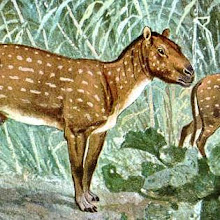Now, I will discuss my favorite prehistoric bird, the Diatryma. Like the Eohippus, this animal is also known by a different name, Gastornis. This change is not as bad as that of Eohippus, so I will not delete comments referring to the Diatryma as “Gastornis.” In case you are wondering, I got all the names I prefer to call these animals now from an older book. I am staying static in what I like to call these animals. By the way, Diatryma has the same situation as Eohippus. Someone named Gaston Planté discovered the first fossils and named it after himself “ornis” means bird, “ornithology” is the study of birds. Anyway, later in America someone named Edward Drinker Cope found a more complete skeleton and named it Diatryma, ancient Greek for canoe. Okay, the name isn’t very flattering, but still. Just because he found it second?! The second skeleton was more complete anyway! By the way, I changed my mind; all comments with Diatryma’s bad name will also be deleted. My rage is possibly also attributed to two things: One, they used to call it Diatryma, and they didn’t change it to the Bad name until during or after the late 20th century. Second:
MY BELOVED EOHIPPUS IS IN THE SAME SITUATION!!!!!! Anyway, now that my rage has mostly faded, I will talk about the Diatryma in more detail. The Diatryma was flightless, large, and fast, just like an ostrich with short wings and a parrot-like beak. Might I add I am getting information from an article,
http://www.suite101.com/article.cfm/paleontology/85674 , which calls it the Diatryma FROM 2001! Why did they make this ridiculous name change idea!? According to this article, the Diatryma was a member of the order Gruiformes, which currently encompasses quite a few waterbirds, like cranes. But some other sources place the Diatryma in the ratite group, like ostriches. It is debatable whether Diatryma was a predator or not. Its hooked beak could have been used for tearing flesh or hard leaves, similar to Triceratops. Currently, it is more widely assumed that Diatryma was a predator. A random final note, no one knows what Diatryma feathers look like. They are assumed to be similar to ostrich feathers, like hairs, but what they are truly like is unknown…
unknown…unknown...

No comments:
Post a Comment